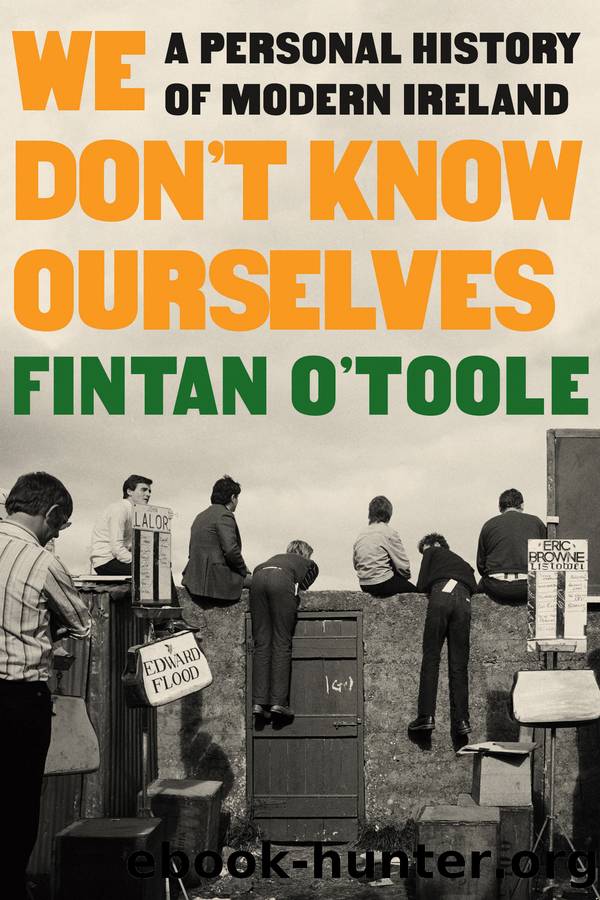We Don't Know Ourselves by Fintan O'Toole

Author:Fintan O'Toole
Language: eng
Format: epub
Publisher: Liveright
Published: 2022-02-12T00:00:00+00:00
23
1979â1982: The Body Politic
Bodies had always been the ultimate currency of the Troubles â bodies shattered, torn apart, broken, beaten, tortured, displayed, disappeared. But, from the point of view of the members of the IRA, the bodies in question were other peopleâs. They belonged to the people they killed. As the surreal saga of Frank Staggâs corpse had shown, however, there was also a tradition of using the Republican body itself as a weapon of war. That saga had also reminded the authorities south of the Border just how dangerous this kind of war could be, how the dead or dying body could take a fierce grip on the living. The British government, though, never really understood this. It allowed itself to be dragged into a conflict it could win physically but would always lose imaginatively â a fight, quite literally, to the death in the H-Block prison complex at Long Kesh, nine miles southwest of Belfast.
The eight single-storey buildings known from their shape as the H-Blocks were, ironically, at the centre of âthe most up-to-date and luxurious prison in Europeâ. The complex had sophisticated training workshops and classrooms, a fine indoor sports hall, two all-weather sports pitches, a hospital and a dental clinic. As David Beresford put it in his sympathetic account of the hunger strikes mounted there by Republican prisoners, âImprisonment in the H-Blocks was a status tens of thousands of prisoners around the world would have envied.â1
Up to 1975, political prisoners in Northern Ireland had been recognized as such and given âSpecial categoryâ status. This system allowed them to wear their own clothes, move freely around the compounds outside the H-Blocks in which most of them were housed, and maintain quasi-military structures, with their own commanders. But, after it ended internment, the British government announced that those convicted of terrorist offences committed after 1 March 1976 would be treated as ordinary criminals and subjected to ordinary prison rules. Brendan Hughes, the IRA commander in the H-Blocks, recalled the âshock to the systemâ â âHere I was that morning being called âMr Hughesâ or âO/Câ [officer in command], now being called â704 Hughesâ and dumped in a cell.â2
What followed was a process of acceleration that no one really planned. Hughes described it as âlike getting on a bike at the top of a hill⦠it gained its own momentumâ.3 It started in September 1976 when one newly arrived prisoner, Ciaran Nugent, asked what size uniform he would take, replied, âYou must be joking me.â He was placed in a cell with just a blanket to cover him. Other new prisoners followed his example. This meant that they were not allowed to leave their cells and lost almost all privileges, including remission of sentences. After furniture in one wing was broken in a confrontation between prisoners and warders, all cell furniture was removed.
In 1978, Hughes decided to escalate the protest. Prisoners going to have their weekly shower were subjected to jeering from warders because they were covered only in a towel.
Download
This site does not store any files on its server. We only index and link to content provided by other sites. Please contact the content providers to delete copyright contents if any and email us, we'll remove relevant links or contents immediately.
| General | Channel Islands |
| England | Northern Ireland |
| Scotland | Wales |
Room 212 by Kate Stewart(5041)
The Crown by Robert Lacey(4731)
Endurance: Shackleton's Incredible Voyage by Alfred Lansing(4683)
The Iron Duke by The Iron Duke(4293)
The Rape of Nanking by Iris Chang(4139)
Joan of Arc by Mary Gordon(4017)
Killing England by Bill O'Reilly(3953)
Say Nothing by Patrick Radden Keefe(3904)
I'll Give You the Sun by Jandy Nelson(3362)
Shadow of Night by Deborah Harkness(3308)
Hitler's Monsters by Eric Kurlander(3269)
Mary, Queen of Scots, and the Murder of Lord Darnley by Alison Weir(3152)
Blood and Sand by Alex Von Tunzelmann(3140)
Darkest Hour by Anthony McCarten(3072)
Eleanor & Park by Rainbow Rowell(3063)
Margaret Thatcher: The Autobiography by Thatcher Margaret(3029)
Red Famine: Stalin's War on Ukraine by Anne Applebaum(2874)
Book of Life by Deborah Harkness(2869)
The One Memory of Flora Banks by Emily Barr(2803)
